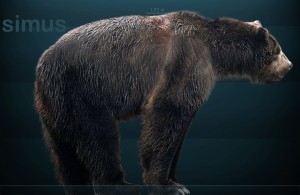In 1878, James D. Richardson explored Potter Creek Cave in Shasta County, California. He found the skull of a bear beneath several inches of cave dirt, and he sent the specimen to Edward D. Cope, who determined that it was the type specimen for a new species of American “cave bear” (Cope, 1879).
When a scientist studies an animal and determines that it is something new to science, they set up a name for it and designate a type specimen. The type specimen, or type, holds a special significance as the “name bearer” for the entire species, and subsequent investigations of that species make reference to the type. They are often kept in special collections within the museums that hold them, or at least given special protection over other specimens. For example, they often are not loaned out as other specimens in the museum collection might be, so there is less risk of damage. (For a description of geologic type sections, see formations).
All too often the type specimens of fossil species have been based on fragmentary material or poor descriptions, making a full understanding of the species more difficult. A famous example of this is the story of the dinosaur Apatosaurus.
Apatosaurus was named by Cope’s rival, O. C. Marsh (Marsh, 1877). Both Cope and Marsh were rushing to describe more fossil species than the other, and their famous rivalry led to shoddy work by both men on occasion. Marsh said the type specimen of Apatosaurus was a “nearly complete specimen in excellent preservation.” However, he only briefly described the vertebrae of this new animal in his haste to publish the new name.
Later, Marsh published the name Brontosaurus, with a few comments on the pelvis and vertebrae of that type (Marsh, 1879). Brontosaurus soon became widely known to the public, and to many, represented the quintessential dinosaur. However, by 1903 Elmer Riggs recognized that Apatosaurus and Brontosaurus were in fact the same species of dinosaur, and since Apatosaurus was named two years before Brontosaurus, that name had priority and was the name that should be used (Riggs, 1903). However, the old name Brontosaurus was in such popular usage that it took many decades for the public to catch on. Now, it seems that every young dinosaur buff knows of this name change and is comfortable with it.
Since the first Short-faced Bear fossil to be recognized in North America was from Northern California, the type specimen, and the name of the bear, Arctodus simus, will be forever linked to the region. This “American Cave Bear” is now known from over 100 localities from Alaska to Mexico, east coast to west (Richards et al., 1996). It was a wide-spread species of the late Pleistocene Ice Age.
What is perhaps most striking about this bear is its size. Arctodus is the largest mammalian carnivore ever discovered. It is larger than any of the modern bears, tigers, or lions by a significant degree. An estimate for the largest Arctodus found to date suggests that if the individual was “lean” it weighed from 1,300 to 1,400 pounds (Nelson and Madsen, 1983). In contrast, a male lion weighs about 450 pounds. (See How big was the GSFB?)
So this imposing carnivore of the Ice Age roamed across North America, and the North State can forever claim it as its own. A full skeletal mount of this beast can be seen in the new Gateway Science Museum at Chico State.
COPE, E. D. 1879. The cave bear of California. American Naturalist, 13:791.
MARSH, O. C. 1877. Notice of new dinosaurian reptiles from the Jurassic Formation. American Journal of Science, 14:514-516.
MARSH, O. C. 1879. Notice of new Jurassic reptiles. American Journal of Science, 18:501-505.
NELSON, M. E., AND J. H. MADSEN, JR. 1983. A giant short-faced bear (Arctodus simus) from the Pleistocene of northern Utah. Transactions of the Kansas Academy of Science, 86(1):1-9.
RICHARDS, R. L., C. S. CHURCHER, AND W. D. TURNBULL. 1996. Distribution and size variation in North American short-faced bears, Arctodus simus, p. 191-246. In K. M. Stewart and K. L. Seymour (eds.), Palaeoecology and Palaeoenvironments of Late Cenozoic Mammals: Tributes to the Career of C.S. Churcher. University of Toronto Press, Toronto.
RIGGS, E. S. 1903. Structure and relationships of opisthocoelian dinosaurs. Part
1: Apatosaurus Marsh. Field Columbian Museum, Geological Series, 2:165-196.
Related Posts:
How big was the GSFB?
Denning behavior
GSFB reexamined
